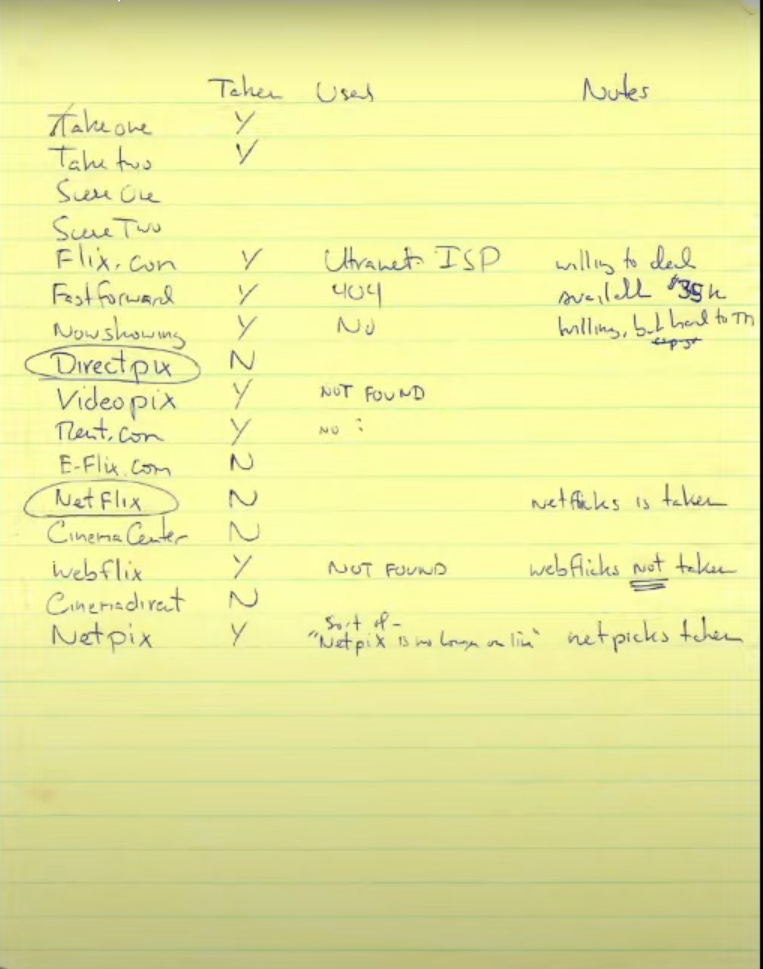The Real Story Behind How Netflix Got Its Name — and Why It Used to Be Called ‘Kibble’ Behind the Scenes
Netflix co-founder Marc Randolph still has the scratch paper he used to come up with the name of the iconic company. Here, he shares the story of the company’s birth and some solid advice for entrepreneurs just starting their journey.
Every successful brand started as nothing more than some scribbles on a piece of paper. The same can be said about Netflix, whose co-founder Marc Randolph still has a copy of the old legal notepad paper used nearly 30 years ago to help create the company (You can see it for yourself below).
When you think of the name “Netflix,” it sounds perfectly fitting and descriptive of what the product is — no substitute can compare. But as Marc experienced, the term had no meaning until he and his team made it into what it is today. Entrepreneurs constantly ask him how he came up with the name, and during an exclusive Q&A with Marc, he gave us the whole story. He also provided some valuable tips for entrepreneurs trying to create the next big brand regarding naming conventions and what landmines you should be paying attention to to save time down the road.
The story of Netflix’s name
Before it launched in 1998 as Netflix.com, the core team held a brainstorming session to develop the name. As Marc describes it:
“We had a whole bunch of names that we were playing with. We did a brainstorming session, and we had words evocative of movies in one column. In the second column, there were words that were evocative of the internet. Then, we began mixing and matching. They were funky names, and I remember a lot of them were already taken like flicks.com. We had ‘net’ in one column and ‘direct picks’ in the other.
But back in 1997, a porno was called a ‘skin flick’ — so flix. And we were going like, oh God, that ‘x’ does not help anything. But everything else was bad. And so eventually we said, ‘Well, Netflix it is — it sounds a little porny — but I guess it’s the best we can do.'”
Here is an image of the yellow legal notepad that Marc shared:
What he learned from the process
As simple as the name Netflix is, Marc described the process as nothing short of brutal.
“You have to find something evocative of what you’re doing. You’ve got to find something that doesn’t look like you spelled it a way that looks like you were drunk when you were playing Scrabble.”
On top of that, Marc reiterated the importance of doing your research. Check domains and trademarks, he said. And if you use an arbitrary or fanciful term, make sure it doesn’t have an obscene meaning in another language.
Make sure to pick two names
During their launch, Netflix was the customer-facing name — but what was the company’s name as it appeared on legal documents and payroll? It was Kibble.com.
Marc explains why they picked something completely off-brand for a DVD shipping company that was starting out:
“When you start, you need to use a beta name. That’s the name you’re going to use to incorporate. It’s the name you will use to pay people and issue stock. Some advice I got from one of the guys on my board was to pick a bad name for your beta name.
Related: 5 Trends Entrepreneurs Should Consider When Naming a Startup
When you inevitably get into the struggle that comes with branding revisions, choosing a bad beta name will ensure you aren’t tempted to use it as the face of the company.”
So why Kibble.com? Marc already owned the domain, and as a marketing expert, he felt it was indicative of this important marketing principle:
“No matter how good your marketing is: If the dogs don’t eat the dog food, it doesn’t make a difference.”
If you would like to see more about how Marc started Netflix and his advice to CEOs, check out the full interview here:
Quotes from Marc Randolph have been edited for length and clarity.
Every successful brand started as nothing more than some scribbles on a piece of paper. The same can be said about Netflix, whose co-founder Marc Randolph still has a copy of the old legal notepad paper used nearly 30 years ago to help create the company (You can see it for yourself below).
When you think of the name “Netflix,” it sounds perfectly fitting and descriptive of what the product is — no substitute can compare. But as Marc experienced, the term had no meaning until he and his team made it into what it is today. Entrepreneurs constantly ask him how he came up with the name, and during an exclusive Q&A with Marc, he gave us the whole story. He also provided some valuable tips for entrepreneurs trying to create the next big brand regarding naming conventions and what landmines you should be paying attention to to save time down the road.
The story of Netflix’s name
Before it launched in 1998 as Netflix.com, the core team held a brainstorming session to develop the name. As Marc describes it:






